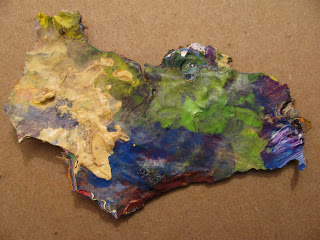The short-blooming Korean lilac in our backyard has only a few redeeming virtues -- but one sterling virtue is its draw as a butterfly magnet. With this year's early growing season, though, the lilac had bloomed and faded by the time the butterflies arrived. I've seen a few swallowtails, but none are lingering in the back yard, and I have yet to see a red admiral; this one visited in 2014.
Still, butterflies were on my mind when I recently scraped down my palette. Almost any artist who writes about methods has one non-negotiable rule:-- At the end of each session, clean up your palette so you'll start fresh the next time with a clean slate. Without apologies, it's a rule I've almost never followed.
My usual routine is: Work with my paints. Try to save some of the paint pools for the next day. Then work around or on top of some inevitably dried-up blobs of paint. Repeat. Where conflicting colours become confusing, paint over them with a neutral grey. When the dried blobs become too bumpy, scrape them off -- a time-consuming but meditative practice.
In my recent scraping experience, I again savoured the surprise of the random justapositions of colour.
I was reminded of my brother, an ace teenaged car mechanic in the 1950s, dismantling and reconstructing old cars in our family garage. He once went to a car show and returned with a gift for our indulgent mother, who put her son's hobby ahead of the comfort she might have had in starting her car in winter in the shelter of the garage. The gift was a pair of earrings that had been "carved" in an elegant shape from layers of auto body paint -- quite lovely.
As I cut and scraped my palette, I became enamoured of the slices, even the tiniest chips:
And there was more! Next to my palette was a plastic yogurt container I'd used for acrylic medium (the plastic that, combined with pigment, makes acrylic paint and can also be used on its own as a paste or a thickener). It, too, held swirls of dried colour that could be easily peeled loose.
What could I do with these enchanting colour combinations? Then serendipity struck. I happened to set aside two chips in such a way that -- a butterfly emerged!
From that, it was irresistible to release a whole field of butterflies.
The metamorphosis of butterflies -- an otherworldy process, often a mythical symbol of rebirth, as in my ancestral Gaelic culture. But, but.... how does the real butterfly develop? I thought of caterpillars...
...and then, I confess, I had to go to Google to review what we all learned in grade school about the whole sequence of events.
There was something else in the back of my mind, too, about butterflies...and dreams. Of course:-- the internet would provide! There I found the philosopher's butterfly dream.
"Once, Chuang Tzu dreamed he was a butterfly, a butterfly flitting and fluttering about, happy with himself and doing as he pleased. He didn't know that he was Chuang Tzu. Suddenly he woke up and there he was, solid and unmistakable Chuang Tzu. But he didn't know if he was Chuang Tzu who had dreamt he was a butterfly, or a butterfly dreaming that he was Chuang Tzu. Between Chuang Tzu and the butterfly there must be some distinction! This is called the Transformation of Things."











No comments:
Post a Comment